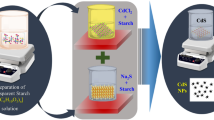Abstract
Starch capped PbS, CdS and PbS–CdS nanocomposites are conjugated with Calf–Thymus DNA. All the materials are characterized by X-ray diffraction, high-resolution transmission electron microscopy, UV–Vis spectroscopy and photoluminescence spectroscopy. The x-ray diffraction patterns of PbS and CdS show that the materials possess polycrystalline having both cubic and hexagonal phases. High resolution transmission electron microscopic results (HRTEM) shows PbS nanoparticles of size 3 nm and that of CdS nanoparticles having average size 4 nm which exhibit tendency of agglomeration. In case of PbS/CdS, it exhibits different types of nanosheets. The UV absorption spectra of all the samples exhibit clear blue-shift with the respective bulk absorption edges. This is attributed to the strong quantum confinement in the materials. The absorption spectra also exhibit increase of the band gaps from 2.25 to 4.35 eV for PbS; 2.25–4.2 eV for CdS with decrease of molarities from 0.1 to 0.001 M as well as conjugated with DNA. The photoluminescence spectra of all PbS, CdS and PbS/CdS composites synthesized at 0.1 M molar concentration show a further blue shift and an enhancement of intensity after conjugation with DNA, but the effect is reversed i.e. occurrence of red shift and reduction of intensity for those having 0.01 M. This is due to the two competing processes of surface passivation as well as stabilization of nanocomposites governed by bio-molecules and that of Dexter energy transfer with the effective charge separation. The result shows the applicability of the materials in development of biological labels and biosensors.







Similar content being viewed by others

References
X Shen, Z Li, Y Cui and Y Pang Int. J. Electrochem. Sci. 6 3525 (2011)
C Liu, Y Jiang, J Huang and H Duan Int. J. Nanosci. 6 3121 (2012)
G Mandal and T Ganguly Indian J Phys. 85 1229 (2011)
S Bhushan and A Shrivastava Indian J. Phys. 84 1517 (2010)
S Jana, R Thapa, R Maity and K K Chattopadhyay Phys. E 40 3121 (2008)
D M M Atwa, I M Azzouz and Y Badr Appl. Phys. B 103 161 (2011)
K J Mispa, P Subramaniam and R Murugeson Chalcogenide Lett. 5 335 (2010)
C C Uhuegbu Can. J. Sci. Ind. Res. 6 230 (2011)
X Zhao, I Gorelikov, S Musikhin, S Cauchi and V Sukhovatkin Langmuir 21 1086 (2005)
J Akhtar, et al. J. Mater. Chem. 20 2336 (2010)
L Bakueva, I Gorekilov, S Musikhin, X S Zhao, E H Sergeant and E Kumucheva Adv. Mater. 11 126 (2004)
N Faleni and M J Moloto IJRRAS 14 127 (2013)
M Rahnkim, Y M Kanoj and D J Jang J. Phys. Chem. C 111 18507 (2007)
J Song, Z Dai, W GUO, Y Li and W Wang Prz. Elektrotech. 1b 89 (2013)
N Ma, J Yang, K M Stewart and S Kelley Langmuir 23 12783 (2007)
N M Bakhori, N A Yusof, A H Abdullah and M Z Hussein 2nd ICESB 48 138 (2012)
A Merkoce Biosens. Bioelectron. 2b 1164 (2010)
M F Frasco and N Chaniotalis Sensors 9 7266 (2009)
S Gulia and R Kakkar Adv. Mater. Lett. 12 876 (2013)
Y Fu, X Wang, J Zhang and W Li Curr. Opin. Biotech. 28 33 (2014)
N Ma, G Tikhomirov and S O Kelley Acc. Chem. Res. 43 173 (2010)
N Choudhury and B K Sarma Indian J Pure Appl. Phys. 46 261 (2008)
Y A Kalandaragh, M B Muradov, R K Mamedov, M Behboudnia and A Khodayari Optoelectron. Adv. Mater. 2 42 (2008)
A D Mohammed, D C Onwudiwe, D A Young and H C M Vosloo Mater. Lett. 114 63 (2014)
M A Mohammed, A M Mousa and J P Ponpon J. Semicond. Tech. Sci. 9 117 (2009)
M A Barote, S S Kamble, A A Yadav, R V Suryavanshi, L P Deshmukh and E U Masumdar Mater. Lett. 78 113 (2012)
H C Warad, S C Ghosh, B Henstanson, C Thanachayanont and J Dutta Sci. Technol. Adv. Mater. 6 296 (2005)
R R Thankaleshmi, S Dixit and A C Rastogi Adv. Mater. Lett. 4 9 (2013)
S Y Jang, Y M Song, H S Kim, Y J Cho and Y S Seo ACS Nano 4 2391 (2010)
G H Yue, P X Yan, J Z Liu, D M Qu, Q Yang and X Y Fan J. Cryst. Growth 293 428 (2006)
Y Wang, Q Guo, S Lin, B Chen and D Zheng J. Phys.: Conf. Ser. 152 012018 (2009)
D Kumar, G Agarwal, B Tripathi, D Vyas and V Kulshrestha J Alloy. Compd. 484 463 (2009)
B Zhang, G Li, J Zhang, Y Zhang and L Zhang Nanotechnology 14 443 (2003)
A A Lutich, G Jiang, A S Susha, A L Rogach, F D Stefani and J Feldmann Nano Lett. 9 2636 (2009)
C H Vannoy, A J Tavares, M O Noor, U Uddayasankar and U J Krull Sensors 11 9732 (2011)
Acknowledgments
We acknowledge Department of Chemistry, Gauhati University for providing UV–Vis and PL Characterization, CIF and Department of Physics, IIT Guwahati for giving the facilities for HRTEM and XRD measurements. We also acknowledge Department of Bio-Technology, Gauhati University for providing the DNA solution.
Author information
Authors and Affiliations
Corresponding author
Rights and permissions
About this article
Cite this article
Das, D., Konwar, R. & Kalita, P.K. Optical properties of DNA induced starch capped PbS, CdS and PbS/CdS nanocomposites. Indian J Phys 89, 845–855 (2015). https://doi.org/10.1007/s12648-014-0645-9
Received:
Accepted:
Published:
Issue Date:
DOI: https://doi.org/10.1007/s12648-014-0645-9



